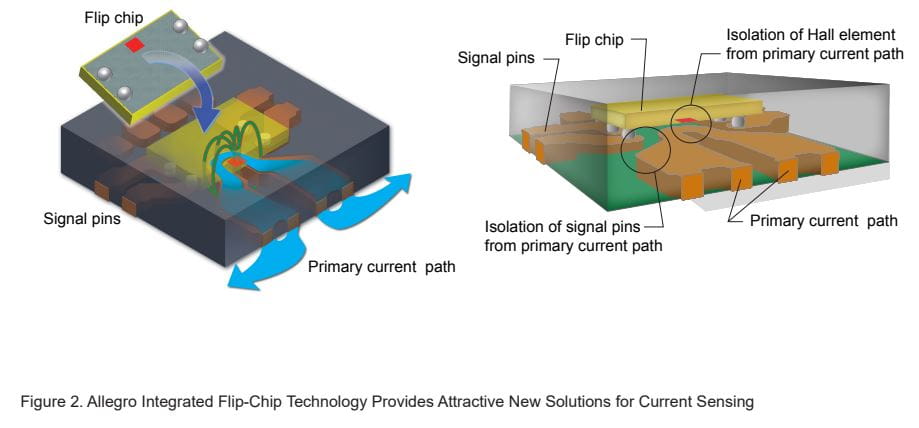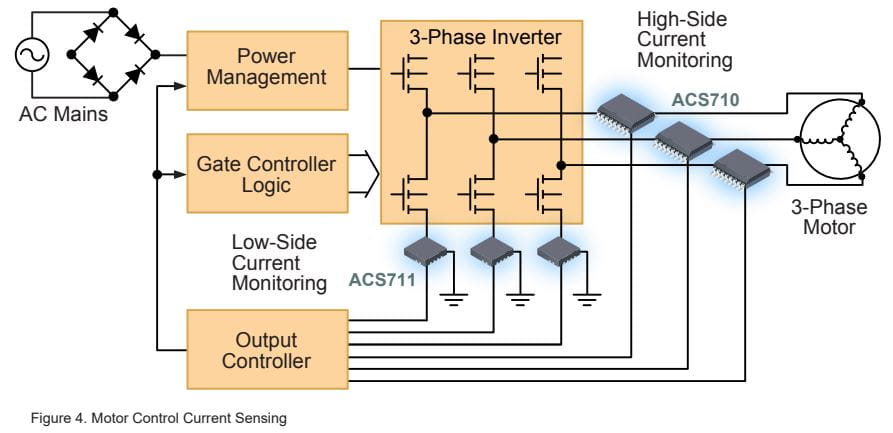New Approaches to High-Efficiency Current Sensing: Integrated Hall Sensor ICs Save Power and Space
Recent advancements in integrated Hall-effect current sensor technology provide an alternative current sensing solution that reduces power loss, achieves most cost targets, and occupies a much smaller volume on the application printed circuit board.
Current Sensing with a Sense Resistor and Amplifier
Conventional current sensing techniques insert a sense resistor in series with the conductor carrying the current being measured. An amplifier is also required, so that when current flows through the resistor, the voltage developed can be used to measure the input current. The value (usually ranging from 1 to 100 mΩ) of the sense resistor depends on the maximum target current that is to be sensed. Smaller sense resistor values develop a lower signal-voltage when current is applied.
The resistor-amplifier sensing circuit is implemented as a shunt circuit, either on the low side (near ground potential) or on the high side (near supply potential) of the load that carries the applied current. High-side current sensing allows the detection of short-circuit conditions to ground potential and is largely immune to ground potential disturbances. Ground potential disturbances become a greater concern when multiple low-side current sense resistors are connected in parallel (to reduce power loss), because this can cause parasitic ground-loops. The disadvantage of high-side sensing is that depending on the high-side voltage, the amplifier circuitry must be able to operate with high common-mode input voltage signals, making the design more complex and the solution more expensive. Low-side sensing relaxes the common-mode input requirements for the amplifier circuitry, but it is also more susceptible to disturbances in system ground potential, and it is unable to detect short-circuit conditions from supply to ground potential.

In sense resistor implementations, measurement accuracy is largely limited by the temperature coefficient, TC, of the sense resistor and the input offset error, VOSI , of the amplifier. A smaller value sense-resistor usually results in degraded accuracy performance since the amplifier’s input offset error now constitutes a larger percentage of the applied signal at the amplifier input. The use of a larger value sense resistor, while beneficial for output accuracy, results in higher power dissipation. As a result, the sense resistor value for a design is usually chosen based on a design trade-off between sensing accuracy and power dissipation.
Consider that a typical current sense resistor value for low-side applications is on the order of 20 mΩ. For a 30 A continuous current-sense application, the power dissipation from resistive losses would be:

This power, dissipated as heat, requires the use of often larger and more expensive, high wattage resistors that employ special thermal technology such as heat-sink mounting and exposed metallic pads for heat dissipation. This power loss also makes the solution energy-inefficient, an increasingly important consideration in portable electronics and eco-friendly design.
Improved Current Sensing with Integrated Hall Technology
Another drawback of sense resistor techniques is they often lead to a volume penalty in the application PCB because thermal considerations have to be taken into account when so much energy is being dissipated as heat. Figure 1 compares the minimum volumes and PCB footprints occupied by a typical sense resistor (TO-220) and op-amp (SOT-23) solution, with PCB consumption by Integrated Hall-effect based current sense techniques (QFN and SOIC).
Allegro’s integrated Hall-effect current sensor ICs use patented flip-chip technology, illustrated in figure 2, to integrate a high accuracy, current carrying conductor into an area- and thermally efficient, monolithic package. Current flows in and out of the package through the primary conductor loop. This current generates a magnetic signal that is sensed by the Hall transducer, shown as the red square in figure 2, and is converted to a voltage. The Hall voltage is galvanically isolated from the primary current, and is dependent on the direction of the current flow, allowing for bi-directional current sensing in both AC and DC modes. The transducer is placed in the area of highest flux density to optimize the magnetic coupling. Since the die surface with the Hall element is now closest to the primary conductor, this approach optimizes transducer sensitivity and accuracy.

The magnetic field generated by current flowing through a conductor is not temperature dependent. As a result, the integrated Hall approach has one less temperature-dependent error term compared to the sense resistor and amplifier technique. The conductor resistance of integrated Hall ICs is as low as 0.6 mΩ, an order of magnitude smaller than most sense resistors employed in low-side sensing configurations. This saves power consumption in customer applications and provides a higher efficiency and more eco-friendly solution. The small footprint also saves PCB area, thereby reducing overall system cost. Table 1 compares the area and power dissipation for a 30 A continuous current sense application for a sense resistor and amplifier solution, and Allegro’s ACS711 QFN and ACS710 Hall effect ICs.

Smart Battery Current Sensing
An increasingly relevant example of a low-side current sensing implementation is charge current monitoring for smart battery systems. In addition to the two battery terminals, these battery systems typically have two diagnostic signals: a single-wire data line for battery health, and a single-wire thermistor output for battery temperature monitoring. These diagnostics are referenced to the negative terminal of the battery.
When using a sense resistor in this application a design engineer must take various error terms into account. First, the resistor will dissipate energy from the battery as heat, making the system inefficient. Second, the voltage, VSENSE , developed across the sense resistor will be superpositioned on the thermistor voltage, VTHERM , such that the voltage seen by the charge controller is VSENSE + VTHERM , resulting in an error in the monitored battery temperature (figure 3). This could affect the charging control of the battery system and eventually hamper battery life. Lastly, the sense resistor approach yields reduced accuracy when using lower sense resistor values, as discussed earlier in this article.
In the case of the integrated Hall-effect sensor, the conductor resistance is lower (as low as 0.6 mΩ), which greatly reduces power dissipation. There is practically no voltage developed across the conductor loop terminals, which helps maintain the integrity of the thermistor’s diagnostic signal. Lastly, since the sensing is based on magnetic coupling, there is no dependence between conductor resistance and accuracy, simplifying the design.

Current Sensing for Motor Control in White Goods
Energy efficiency, safety, reliability, and low-cost are required in motor control circuits for appliances such as refrigerators, washing machines, and air conditioners (referred to as “white goods”). Integrated Hall-effect current sensors can provide compact current-sensing solutions with inherent high voltage isolation (figure 4). Power consumption from current sensing can also be reduced significantly with integrated Hall ICs since they have very low primary conductor resistance. This helps meet energy efficiency requirements such as Energy Star. These sensor ICs also provide a means of rapid detection of fault conditions that can prevent expensive system damage, improving reliability.

Summary
Allegro MicroSystems has developed a line of fully integrated Hall-effect current sensor ICs that provide highly accurate, low noise output voltage signals proportional to an applied AC or DC current. Allegro’s proprietary integrated Hall-effect devices employ advanced IC and packaging techniques for sensing current from 5 A to 200 A. Allegro current sensor ICs allow design engineers to use Hall-effect based current sensor ICs in new applications where increased energy efficiency or new operating features are required. Wherever current sensing is needed, an integrated Hall-effect IC can provide a solution.
Originally published in Design News, February 2013, Copyright ©2013 UBM Electronics. Reprinted with permission. Portions not copyrighted by UBM Electronics, Copyright 2022 Allegro MicroSystems. All rights reserved.
Copyright 2022, Allegro MicroSystems. Allegro MicroSystems reserves the right to make, from time to time, such departures from the detail specifications as may be required to permit improvements in the performance, reliability, or manufacturability of its products. Before placing an order, the user is cautioned to verify that the information being relied upon is current.
Allegro’s products are not to be used in any devices or systems, including but not limited to life support devices or systems, in which a failure of Allegro’s product can reasonably be expected to cause bodily harm. The information included herein is believed to be accurate and reliable. However, Allegro MicroSystems assumes no responsibility for its use; nor for any infringement of patents or other rights of third parties which may result from its use.
Copies of this document are considered uncontrolled documents.